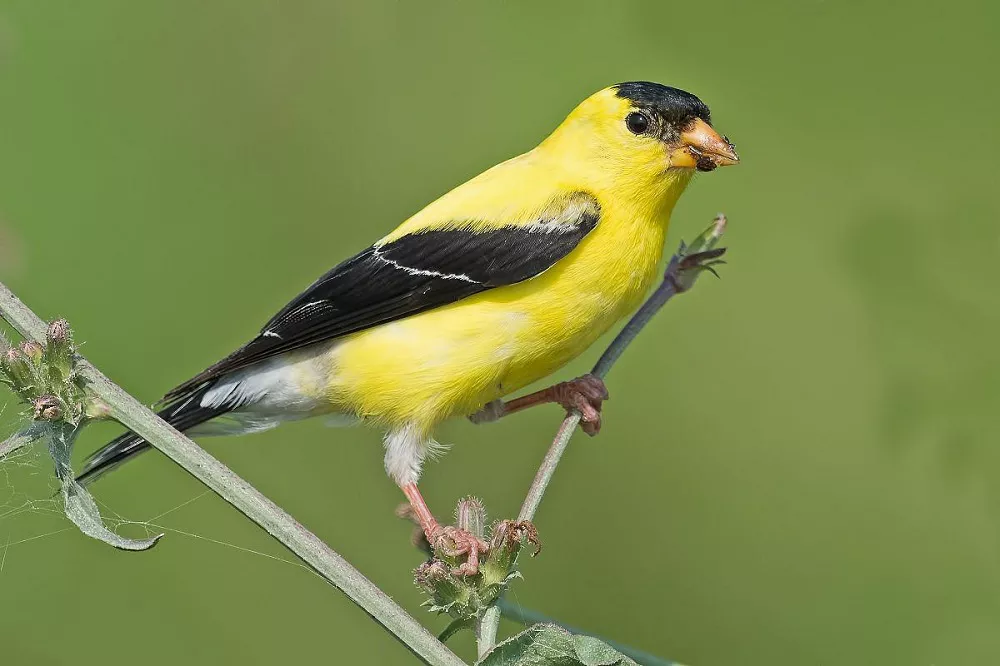Yellow finches, also known as American goldfinches (Spinus tristis), are small, vibrant songbirds that captivate birdwatchers with their stunning yellow plumage and melodic chirping. But do these feathered friends migrate? In this article, we’ll take a closer look at the migration patterns of yellow finches to answer that question.
Introduction to Yellow Finches
The yellow finch is a small songbird that belongs to the family Fringillidae. The scientific name of the species is Spinus tristis. It is native to North America and can be found throughout the continent, from Canada to Mexico. Yellow finches are primarily seed-eaters and are known to frequent backyard bird feeders filled with seeds such as sunflower, thistle, and nyjer.
Breeding and Nesting Habits
Yellow finches breed in the late summer and early fall season, typically between July and October. During the breeding season, males develop a brighter yellow plumage to attract females. Females construct nests using materials such as plant fibers, grasses, and animal hair. The nests are built in trees or shrubs, and the female lays 3-7 eggs.
Migration Patterns
So, do yellow finches migrate? The answer is yes. However, the extent of their migration depends on their location and the time of the year. Yellow finches that reside in northern regions, such as Canada, tend to migrate southward during the winter months in search of warmer weather and food sources. Meanwhile, yellow finches that live in more southern regions, such as Florida, may not migrate at all or only migrate short distances.
Yellow finches are considered “partial migrants,” which means that only some individuals within a population migrate, while others remain in one location throughout the year. This is different from “obligate migrants,” such as certain bird species, that migrate every year.
During migration, yellow finches travel in flocks and can cover long distances, sometimes traveling up to 1,500 miles. They typically fly during the day and roost at night. Migration patterns may vary depending on factors such as weather conditions and food availability.
Factors Influencing Migration
Yellow finch migration is primarily triggered by environmental factors such as food availability, temperature, and daylight duration. During breeding season, when seeds and insects are abundant, yellow finches reside in areas with ample resources for nesting and raising their young. As winter approaches and food becomes scarce, they migrate to lower elevations where they can find sustenance in the form of seeds from plants such as coneflowers, sunflowers, and thistles.
Migration Routes
The migration routes of yellow finches vary depending on their geographical location. In general, populations in the northern parts of their range tend to migrate southward during the colder months, while populations in the southern regions may exhibit shorter or less pronounced migrations. The timing and distance of migration can also differ, with some yellow finches traveling only a few hundred miles, while others may cover longer distances.
Migration Adaptations
Yellow finches have evolved several physiological and behavioral adaptations to facilitate their migratory journeys. One notable adaptation is their ability to change their diet. During the breeding season, their diet consists mainly of insects and protein-rich foods, while in winter, they rely heavily on seeds. This dietary flexibility allows them to adjust their feeding habits based on the availability of resources along their migration route.
Conservation Considerations
Understanding the migratory patterns of yellow finches is vital for conservation efforts. As habitat loss, climate change, and other human activities continue to impact the environment, it is crucial to ensure the availability of suitable habitats and food sources along their migration routes. Planting native flowering plants that produce seeds and provide shelter can aid in supporting yellow finches during their journeys. Additionally, efforts to preserve and restore diverse ecosystems will contribute to the overall conservation of these charismatic songbirds.
Citizen Science and Research:
Citizen science initiatives play a crucial role in studying yellow finch migration. Birdwatchers and enthusiasts can contribute valuable data by participating in programs such as the Great Backyard Bird Count or Project FeederWatch. These initiatives help scientists track and analyze yellow finch populations, migration timing, and distribution patterns, providing valuable insights for conservation strategies and habitat management.
Conclusion:
In summary, yellow finches do migrate, although the extent of their migration depends on their location and the time of the year. These beautiful songbirds are partial migrants, meaning that only some individuals within a population migrate. By understanding their migration patterns, we can better appreciate and protect these lovely creatures. Whether they’re visiting our bird feeders or flying overhead during migration, yellow finches are a delightful addition to any backyard birdwatching experience.
Related Topics:
- What Do Yellow Finches Eat?
- What Does a Yellow Finch Look Like?
- Where Do Yellow Finches Go in the Winter?


 Facebook
Facebook  Instagram
Instagram  Youtube
Youtube 